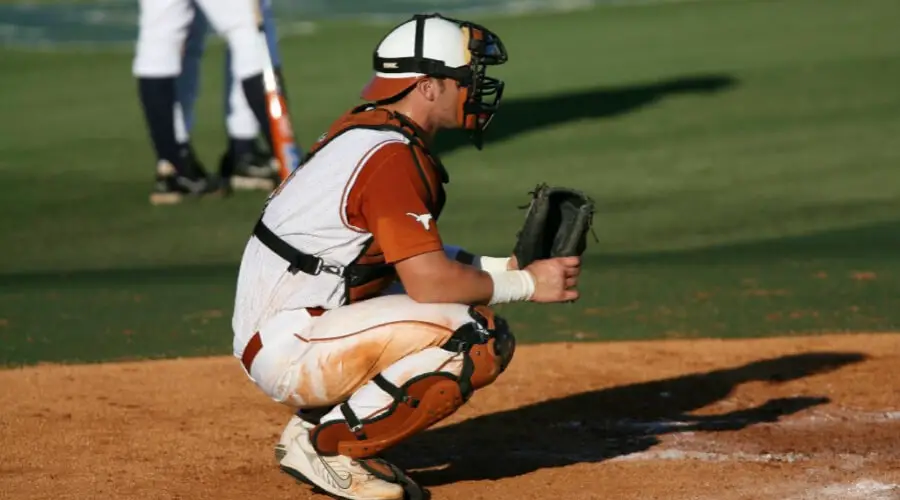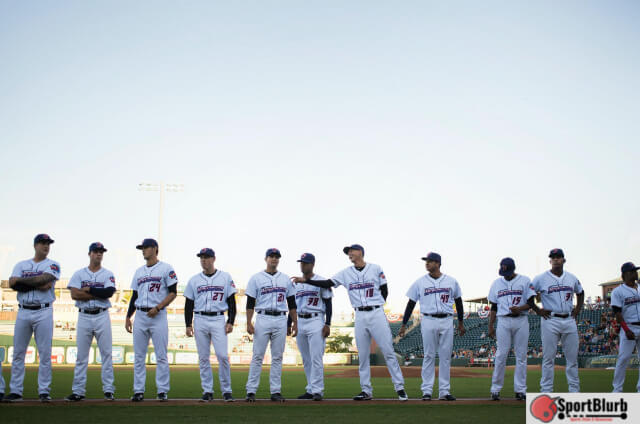Last Updated on October 22, 2023 by Alex PT
There are 9 players on a baseball team in the field at a time. The positions are:
- Pitcher (P)
- Catcher (C)
- First baseman (1B)
- Second baseman (2B)
- Third baseman (3B)
- Shortstop (SS)
- Left fielder (LF)
- Center fielder (CF)
- Right fielder (RF)
Different Positions In Baseball
| Players On A Baseball Field | About |
| Pitcher | The pitcher is known as the defensive player that starts every individual play. |
| Catcher | The catcher is called the field general defense because they are the only players facing the playing field. |
| First baseman | The first baseman, after the pitcher and catcher, is the most involved defensive player based on action on the field. |
| Second baseman | The second baseman is a middle infielder. |
| Third baseman | The third baseman is at a hot corner because the third base needs a fast reaction time during the game. |
| Shortstop | Shortstop is the anchor of the other infield defense and the other infield positions. |
| Left fielder | The left fielder stays at one of the outfield positions. They are the farthest from home plate and they have lesser territory to cover. |
| Centre fielder | The center fielders are seen to be one of the most important field positions. |
| Right fielder | A right fielder is mostly a hitter who also plays at another corner outfield position. |
Positions In Baseballs

Pitchers
The pitcher without a doubt is the most essential position in baseball. Whoever toes the rubber decides so much in the game. There’s a saying in baseball that says “ pitching wins championships.” There is a lot more to pitching than we know, we will tell you more about that. We have the starting pitcher who starts the game in the first inning. When a pitcher can’t throw for the whole nine innings, he puts the ball on the bullpen. The bullpen includes the relief pitchers like the closer (pitches the last inning), the setup man, middle relief, and long relief pitchers. Most teams have left-handed pitchers that go against the left-handed hitters.
Catchers
The catcher dictates the game. Leaned behind home plate, they order and collect pitches from the pitcher. Most times field bunts and throw-out runners try to steal the bases. Catchers are also climactic in assisting pitchers to get strike calls from the umpire behind by making pitches look like they were strikes. Catchers are rarely left-handed. The backstop has more protective gear than other players, so the catcher makes sure no pitch gets by him. His mitt is also thicker than the others, this enables him to repel pitches.
First Baseman
The first base position is where the big-bodied players are. They are in charge of the first base area and other bigger duties like receiving groundball throws, holding the runners at first base, and stopping balls hit by left-handed hitters. They require big Witt-like catchers and a wide web. The position doesn’t require range like other positions, so first basemen do not have range. This is what makes most infielders move to first base later in their career because they can’t cover as much ground as they used to. Most of these first basemen are left-handed because right-handed players find fielding and throwing easier.
Second Basemen
Second basemen don’t stand exactly at second base anymore, they stay in between first and second base. Second basemen are known for their smooth hands and fast throw, that is, they can get a ball off their gloves easily. They don’t have strong arms because their throws are short-distance. These players take up one-half of the middle infielders and they have a very wide range to cover because the first baseman has none.
Third Basemen
The third base is called a hot corner in baseball. The third basemen must have fast reflexes for screaming line drives and hard hits from righties. They also require strong arms to throw the ball fast across the diamond to first base. We feel like third basemen are the most talented in this sport because they require a wide range of field balls to the left and right and bunts in their front.
Shortstop
The shortstop is just after the second base and before the third base. The player in this position must also have strong arms. These players are the most athletic in the defense. Players here require range, speed, arm strength, and precision. They must also be good with gloves. Shortstops also get more ground hits than any other position, they require consistency. Apart from the ground balls, the shortstop also cut off fly balls and balls that outfielders don’t track.
Left Fielders
Outfielders require fewer skills than other outfield positions. This position is also called home, and the throws that catch base runners at home are mostly short so these players don’t require strong arms. Left fielders require a decent speed, range, and also the ability to assess a fly ball.
Center Fielders
The best baseball players of all time were mostly center fielders. The reason behind this is that these players track down more flying balls than any other position, they are also very fast. Players in this position require strong arms. The center fielder is seen as the captain of the outfielders so he calls his fellow outfielders to the balls in the gap. The position is really hard so it’s reserved for only the best players.
Right Fielders
Right fielders require big strong arms because they make the longest throw in the game which is from the right into third base. The right field is where most teams hide their younger less talented players because there is less action in that position.
What are the rules for positions in baseball?
- Pitcher (P):
The pitcher starts the game by throwing the ball from the pitcher’s mound toward the catcher, with the attempt to strike out the batter. The pitcher is also responsible for fielding any balls that come within the infield. - Catcher (C):
Situated behind the home plate and the batter, the catcher catches pitches that the batter doesn’t hit. The catcher is also a strategist, providing signals to the pitcher concerning the type of pitch to throw. - First Baseman (1B):
The first baseman’s primary responsibility is to cover the first base. The person in this role must have quick reaction times to catch throws from other infielders to get the runners out and also field hits that come within their reach. - Second Baseman (2B):
The second baseman covers the area around second base and is responsible for catching balls in that zone, turning double plays, and sometimes covering first base. - Third Baseman (3B):
The third baseman’s role is similar to the first baseman, but on the opposite side of the diamond. This player catches balls hit to this side of the infield and covers third base. - Shortstop (SS):
The Shortstop, positioned between the second and third base, provides coverage for both. This position calls for strong fielding skills and the agility to catch fast ground balls. - Left Fielder (LF):
The left fielder must catch or block any balls hit to the left side of the outfield. The player must also have a strong throwing arm to send the ball back to the infield. - Center Fielder (CF):
The center fielder covers the area directly beyond second base and must quickly field ground and fly balls hit to the center outfield. Strong communication skills are vital to prevent collisions with the left and right fielders. - Right Fielder (RF):
The right fielder must cover the right side of the outfield and field any balls hit to this area. This player also needs to be able to throw the ball with accuracy and power back to the infield.
The breakdown of these positions provides a glimpse into the complex yet exciting world of baseball. While distinct in their responsibilities, all players should work collaboratively to form a cohesive and effective team.
Positions in Baseball and Their Rules
| Position | Responsibilities |
|---|---|
| Pitcher(P) | Throwing the ball from the pitcher’s mound, fielding any balls within the infield |
| Catcher(C) | Catching pitches, strategizing the game |
| First Baseman(1B) | Covering first base |
| Second Baseman(2B) | covering second base, catching balls, turning double plays |
| Third Baseman(3B) | Covering third base, catching balls hit to this side of the infield |
| Shortstop(SS) | Coverage between second and third base |
| Left Fielder(LF) | Covering the left side of the outfield, strong throwing skills |
| Center Fielder(CF) | Covering beyond second base, strong communication skills |
| Right Fielder(RF) | Coverage on the right side of the outfield, |
Conclusion
Each of the nine positions mentioned and detailed out here on defense requires a different level of strength and also gives itself to a specific kind of offensive player. We’ve reached the end of this informative article. We hope that this article helped you find resources in your quest to know how many players are on a baseball field. Do not hesitate to contact us with any questions or comments. Thanks!
References:
https://www.mlb.com/glossary/positions
https://en.wikipedia.org/wiki/Baseball_positions

Hi! I’m Alex PT. I hold a Bachelor’s degree in Sports Management from Indiana University and have over seven years of valuable experience working in a Sports Event Management Company. I founded SportBlurb with the passion for bringing you the latest, most insightful, and engaging content in the world of sports. So, whether you’re a die-hard fan or want to stay informed, I’ve got you covered!

